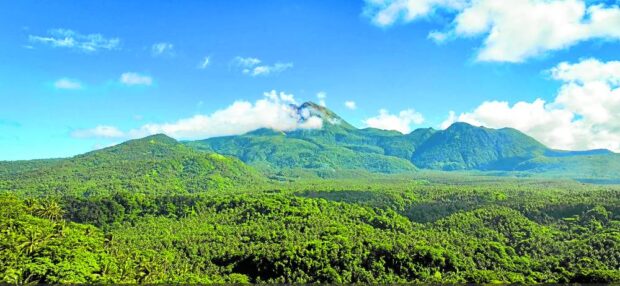
LEGAZPI CITY, Albay, Philippines — Even before officials of Albay province can relax due to the continuing restiveness of Mt. Mayon, local governments in the neighboring province of Sorsogon now have to be on alert after Bulusan volcano also started exhibiting seismic activities, based on the latest records of the Philippine Institute of Volcanology and Seismology (Phivolcs).
Salvador Mendoza, Sorsogon’s provincial information officer, said they were on standby for possible phreatic eruptions of Bulusan volcano, especially in areas usually affected by ashfall.
“The vehicles for rescue, water trucks, and mobile kitchen are always on standby for any eventualities,” Mendoza said in a private chat message on Monday.
Residents in the villages of Irosin, Juban, and Casiguran in Bulusan town who were affected by past eruptions were advised to stay vigilant.
Mt. Bulusan, which currently is still under zero alert level (normal), is only about 70 kilometers southeast of Mayon Volcano, which has been on alert level 3 (high level of unrest) since the middle of this year.
But even if Bulusan is not under any alert level, the volcano’s activities indicated “increased chances of steam-driven or phreatic eruptions occurring at the crater or summit area,” Phivolcs said in an advisory at 9 p.m. on Sunday.
Phivolcs said Mt. Bulusan recorded 87 volcanic earthquakes since Oct. 14 and at least 29 of these were volcano-tectonic earthquakes associated with rock fracturing processes that occurred from 1 km to 8 km beneath the southern and western sectors.
Phivolcs also noted weak to moderate degassing this week at the active summit crater and vents, while volcanic sulfur dioxide gas emission was measured at 241 metric tons per day on Oct. 19.
There has been continued inflation on the southern flank since February and a notable increase in volcanic carbon dioxide concentrations from June to August.
According to state volcanologists, these parameters indicate that hydrothermal activity driven by deep magma degassing may be occurring beneath the volcano and may lead to steam-driven eruptions at any of the summit vents.
Lava effusion
Ken Marc Ragasa, head of the municipal disaster risk reduction and management office of Bulusan, said they already coordinated with the 66 families living in Sitio (subvillage) Talistison of Barangay San Roque to prepare for evacuation, especially persons with disabilities, senior citizens and those with asthma.
Ragasa said Sitio Talistison, located within a 4-km radius of the volcano, was not directly affected by past eruptions, but they usually evacuate residents from vulnerable areas.
“We already relayed to the barangays concerned that the Phivolcs recorded some activities in the volcano, which means the community should not be complacent even if it is under alert level 0,” Ragasa said in a phone interview on Monday.
In Albay, Phivolcs also noted an intensified crater glow at Mayon Volcano on Saturday, which indicates a “slightly increased lava effusion.”
Phivolcs said the phase of increased lava effusion began at 10:10 p.m. on Oct. 21, “with an abrupt intensification of incandescence at the summit crater that was followed by lava flow and rockfall at the Mi-isi and Bonga gullies.”
Summit crack
Paul Karson Alanis, resident volcanologist of the Mayon Volcano Observatory Station at Ligñon Hill here, said they also recorded short-lived gas bursts accompanied by seismic and infrasound signals at 6:36 p.m. on Oct. 20 and 12:06 a.m. the next day.
“The gas bubbles rise, and if they reach near the crater, they will break and sometimes push the lava out. Like if you are cooking spaghetti sauce, once it boils, the bubbles break and push some sauce out of the pan,” Alanis said in a phone interview on Sunday.
He said the increase in lava effusion may also be due to a possible crack at the summit crater.
Cedric Daep, chief of the Albay Public Safety and Emergency Management Office, said in a text message on Monday that once alert level 4 is raised, they would possibly re-evacuate the families who were sent home on Oct. 7.
Early this month, Albay Gov. Edcel Greco Lagman allowed more than 2,000 families to go back to their residences inside Mayon’s 6-km-radius permanent danger zone in the cities of Tabaco and Ligao and the towns of Camalig and Malilipot.
Only the 55 families (211 residents) of Barangay Anoling in Camalig town remained in the evacuation center as their homes were within a 5-km radius of the volcano.
In Phivolcs’ Sunday bulletin, the Mayon Volcano Network recorded 70 volcanic earthquakes, including 65 tremor events, one pyroclastic density current event and 51 rockfall events.
The lava flow was still continuous and advanced to approximately 3.4 km in Bonga gully in Legazpi City, 2.8 km in Mi-isi gully in Daraga town, and 1.1 km in Basud gully in Sto. Domingo town.
Alanis said the data slightly decreased in August, but the volcano remained at alert level 3, or a relatively high level of unrest.
“There was a slight decrease in parameters, but it is still constant if we base it on the overall data. The rockfall events decreased but maintained their average, and yesterday there was an increase in lava effusion,” Alanis said.
On June 8, Phivolcs raised the alert level over the volcano to 3, forcing more than 20,000 individuals to evacuate in the towns of Malilipot, Sto. Domingo, Daraga, Camalig and Guinobatan, and the cities of Tabaco and Ligao.